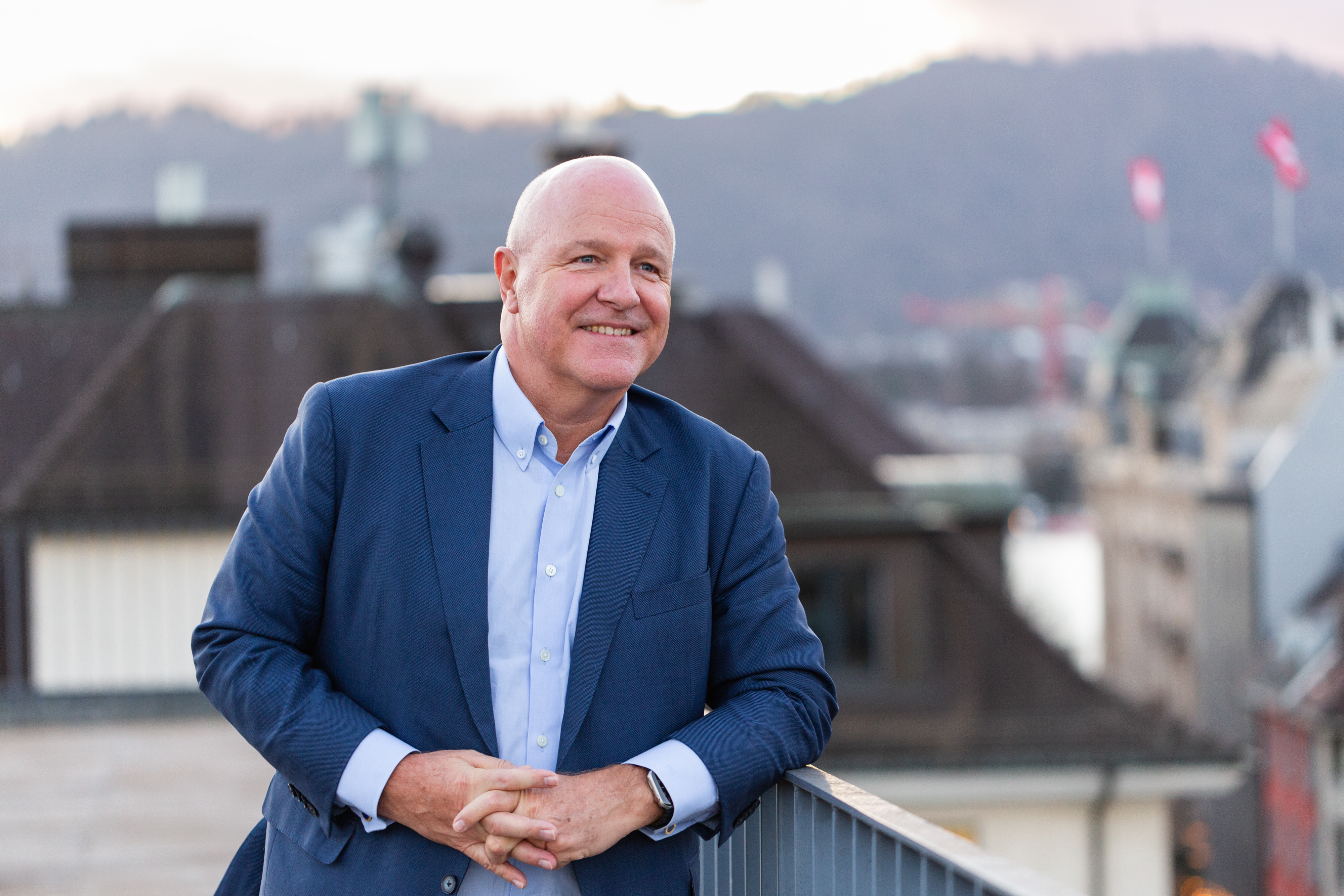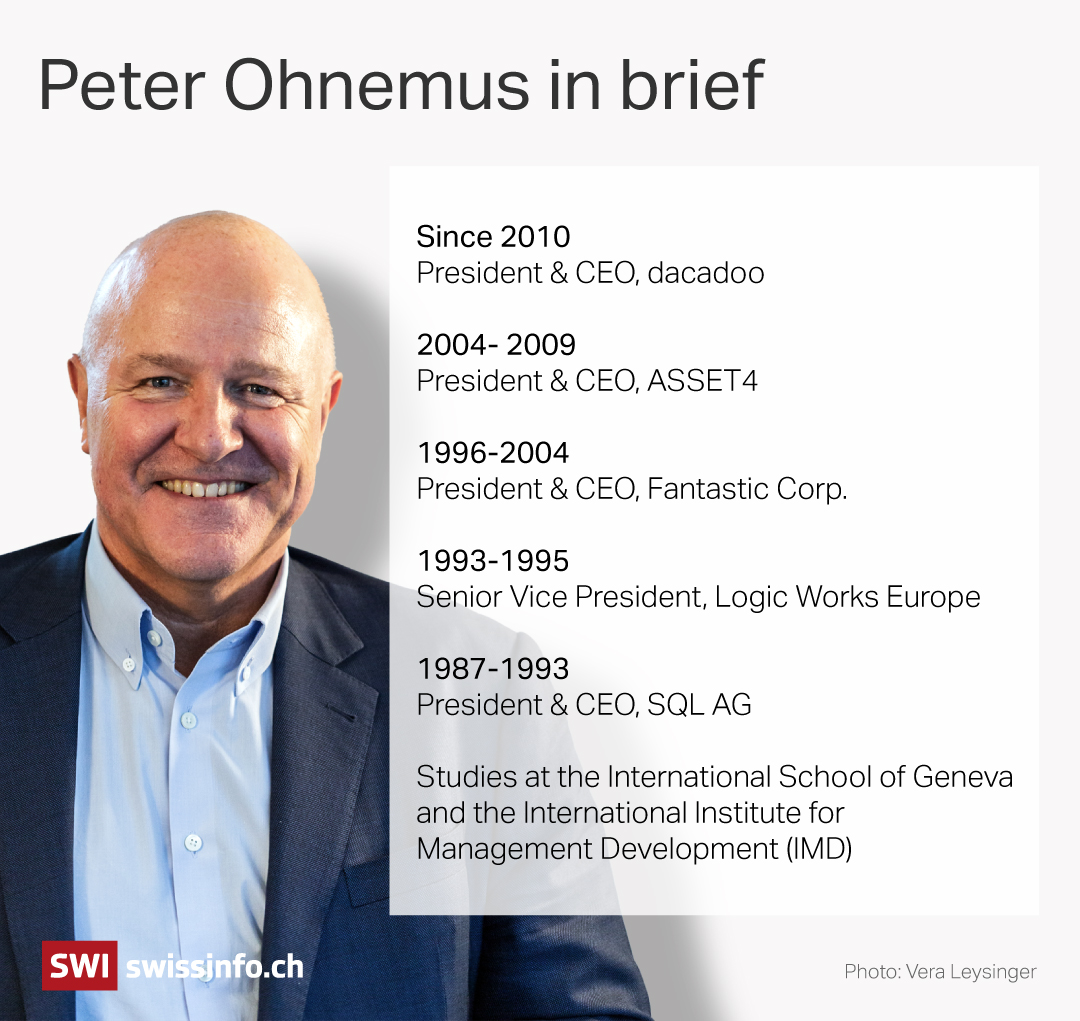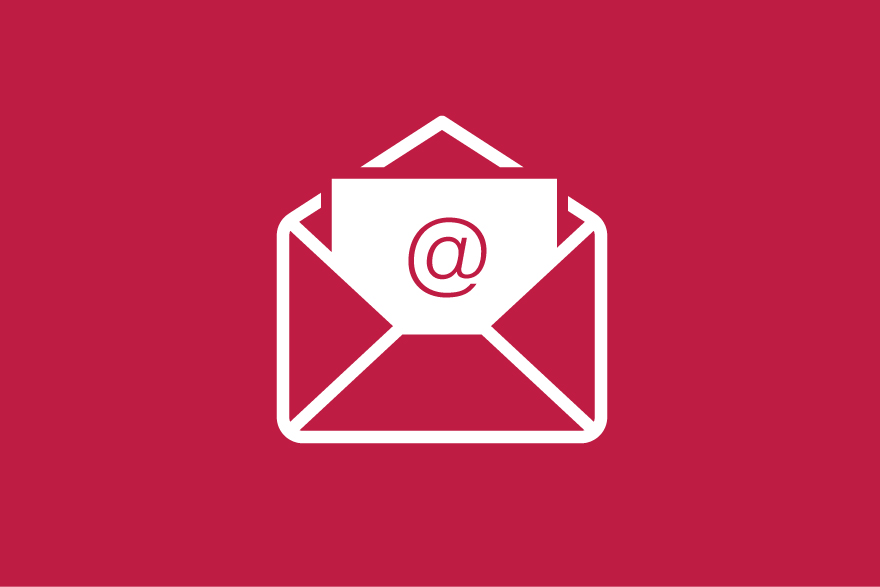
Peter Ohnemus is the founder, president and CEO of dacadoo, a digital health engagement platform.
Vera Leysinger / SWI swissinfo.ch
Peter Ohnemus is CEO of the Swiss-based digital health technology company dacadoo. In an interview with SWI swissinfo.ch, he explains why schools should integrate health in their curriculum and outlines opportunities in keeping ageing populations healthier.
The digital healthcare market is set to grow by around 7% per year for the next five years, as governments grapple to deal with soaring healthcare costs and ageing populations. Statista, a global online data platform, estimates the global market will reach $258.3 billion (CHF233 billion) by 2029, with part of that going to the private sector eager fill a gap left by governments.
These companies offer tools and devices to monitor health and are now positioning themselves as major healthcare players alongside the state and insurance companies.
Among these new companies, Zurich-based dacadoo stands out as a key international player. In an interview with SWI swissinfo.ch, serial entrepreneur Peter Ohnemus, the founder, president and CEO of dacadoo, discusses the significant challenges he faces in turning his vision of better public health into reality.

Decadoo.
Ten key fgures.
Kai Reusser / SWI swissinfo.ch
SWI swissinfo.ch: dacadoo brands itself as a digital health engagement platform. For many people, digital health is a vague concept. What does dacadoo do exactly?
Peter Ohnemus: Our core mission is to help individuals understand an essential but often overlooked topic: their own health.
To achieve this, we invested seven years in foundational research and filed 194 patents, with 100 already granted. These are focused on the relationship between different health parameters. For example, we quantified the relationships between blood pressure, sleep quality, diet, etc. with major health conditions such as type 2 diabetes, cardiovascular diseases and cancer.
To support this research, we received tens of millions in licence fees and funding from prominent organisations, including Walgreens (a United States pharmacy chain), Walmart (a US retailer), AOK (a German health insurer), and Nuffield Health (a healthcare charity from the United Kingdom). All these efforts culminated with the launch of the first version of our dacadoo “Health Score” at the end of 2017.
SWI: Can you explain what your ‘Health Score’ is?
P.O: Our “Health Score” is based on seven key components: nutrition, physical health, mental well-being, sleep, mindfulness, self-control and activity. This score comes from a combination of sources including inputs from users and data collected by smart phones. It condenses these components into a single number, ranging from 1 (worst) to 1,000 (best), providing a clear and comprehensive holistic view of an individual’s overall health. To make the score easy to understand, we represent it visually as a “Wheel of Life” and make it accessible through any smartphone.
More importantly, the “Health Score” is more than just an informational tool. It is designed to encourage users to adopt healthier habits, such as walking more, going to bed earlier, exercising or eating better. To facilitate this, we integrate gamification techniques, making the process of improving one’s health enjoyable. On average, our users improve their “Health Score” by 20%.

Peter Ohnemus shows the “Wheel of Life” on a smart phone. This tool is an incentive to lead a better healthy lifestyle.
Vera Leysinger / SWI swissinfo.ch
SWI: How do you monetise your ‘Health Score’?
P.O: Initially, we aimed to sell our application directly to end-users. However, we quickly realised that building a globally recognised brand and establishing an international infrastructure to cater to end-users would be prohibitively expensive. Therefore, we decided to remain focused as a software company to scale more effectively.
As a result, we shifted our business model to work primarily with health insurance providers. These companies offer our application to their own customers, integrating it into their services. Currently, we serve about 30 global insurance clients, retailers and banks across 40 countries and our application is available in 18 languages, including Mandarin, Korean and Japanese. Swiss clients include SWICA, Swiss Life and Swiss Re. Our Swiss origin is perceived positively, particularly in Asian markets.
SWI: Do healthier end-customers who use your app pay lower premiums for their health insurance?
P.O: It’s not that straightforward. We quickly discovered that the relationship between us and end-customers is mediated by numerous stakeholders, each with split responsibilities. These stakeholders include doctors, various types of insurers, hospitals, and government entities such as, in Switzerland, the Federal Office of Public Health and the Financial Market Supervisory Authority (FINMA). Moreover, regulatory frameworks vary significantly from country to country.
To use Switzerland as an example, compulsory health insurance operates entirely on a solidarity model, i.e., healthier customers do not pay lower premiums. However, their employers benefit greatly if these employees are healthier and less likely to be sick.
Regarding complementary health insurance policies and life insurance, the rules are different. In these cases, healthier customers typically receive several benefits.

dacadoo’s ‘Health Score’ comes from a combination of sources, including user input and data collected from smartphones.
Vera Leysinger / SWI swissinfo.ch
SWI: If we continue to use Switzerland as an example, would users of your app who sign up to a complementary health insurance pay lower premiums? How will insurance companies incentivise users to use your app?
P.O: With complementary health insurance, healthier clients do not benefit from lower premiums. However, when bonus systems are implemented to reward healthy behaviors, these clients receive additional benefits in the form of products, services or cash. This approach incentivises users to engage with our app.
SWI: Would you agree that in most countries there is too much emphasis on treatments rather than prevention? And why is that?
P.O: I couldn’t agree more. Reasons for this vary across countries. Take Germany as an example: according to their health insurance association (GKV), in 2022, €240 billion ($225 billion) was spent on health insurance fees, yet only 0.25% of that amount was allocated to prevention.
With an ageing population, rising obesity due to the industrialisation of cheap food, and younger generations visiting the doctor more frequently, especially after the pandemic, the demand for curative care is unlikely to decrease. Besides, 70% of healthcare costs in Germany are attributable to chronic diseases such as hypertension, type 2 diabetes, and high cholesterol, conditions often associated with unhealthy lifestyles.
In terms of prevention, Japan stands out as a positive exception. Its people are living longer and enjoying a better quality of life. I firmly believe that education plays a crucial role in this. Children should not only learn maths, geography and Latin, but also essential health knowledge, including how to maintain a healthy lifestyle.

“We quickly discovered that the relationship between dacadoo and end-customers is mediated by numerous stakeholders”.
Vera Leysinger / SWI swissinfo.ch
SWI: Your clients include retailers, banks and telecommunication companies. How do these firms benefit from your ‘Health Score’?
P.O: For these clients, our “Health Score” serves as a loyalty-building benefit for their customers. In the case of retailers, for example, customers who purchase healthy foods can receive discounts on future purchases or with partner health insurance companies. In addition, retailers can use insights from our application to improve their offerings. For example, if a customer is identified as an avid runner, the retailer can recommend high-margin products such as the latest running shoes.
SWI: How do you ensure the privacy and confidentiality of your customers data? Do you monetise these data?
P.O: We are strong advocates of data privacy and confidentiality, and we fully support regulations such as the General Data Protection Regulation (GDPR) introduced by the European Union. Because these regulations are inherently complex, we ensure full compliance by leveraging the expertise of our board members, including a partner at Lenz & Stähelin who specialises in this area. We are also firmly committed to protecting our users’ data. We never sell end-user data and use advanced encryption techniques to ensure the highest levels of security and privacy.
SWI: Who are your main competitors? Do they have a white-label strategy, i.e. do they allow their clients to use their own logo in their digital health engagement app?
P.O: There are three major international players in our digital health engagement industry.
Vitality, which is part of Discovery, a listed South African conglomerate. Vitality only offers branded applications and does not offer business-to-business white-label solutions. Personify, now owned by a large American investment firm, focuses entirely on a white-label strategy; it sells its application to companies, which then make it available to their employees.
Finally, dacadoo is the only truly independent business-to-business white-label player among these major competitors; other independent players have either exited the market or lost significant relevance, mainly because their prices were too low.

“Remaining focused as a software company has allowed us to scale more effectively”.
Vera Leysinger / SWI swissinfo.ch
SWI: What about technology giants such as Google, Apple or Samsung?
P.O.: Their approach is fundamentally different as they are primarily focused on selling devices to end-consumers, such as Fitbits (owned by Google), Apple Watch or Samsung Watch. While they could theoretically develop their own expertise and health scoring systems, their solutions would remain tied to their hardware and brand. In contrast, our application platform is completely device-agnostic and can be branded for insurance operators, banks, or retailers.
SWI: Who are your main investors? Are there plans to sell the company or go public?
P.O: We have raised over $70 million to date. Our major shareholders are family offices in Switzerland, Belgium and Japan. In addition, dacadoo’s management team, including myself, holds shares in the company, and a venture capitalist has acquired stakes from some of our early investors, such as Rakuten (Japan) and Samsung (Korea). We prefer to partner with “patient” investors who share our long-term vision, rather than with investors looking for quick returns.
Before the pandemic, we had 120 employees, but we streamlined our operations and reduced our team to 65 employees, which allowed us to achieve profitability. Given the significant growth opportunities within our current business model, we have no plans to sell the company or go public at this time.
Edited by Virginie Mangin/sb

Kai Reusser / SWI swissinfo.ch
More

More
Newsletters
Read More: ‘Children should learn how to maintain a healthy lifestyle, not just maths and geography’


